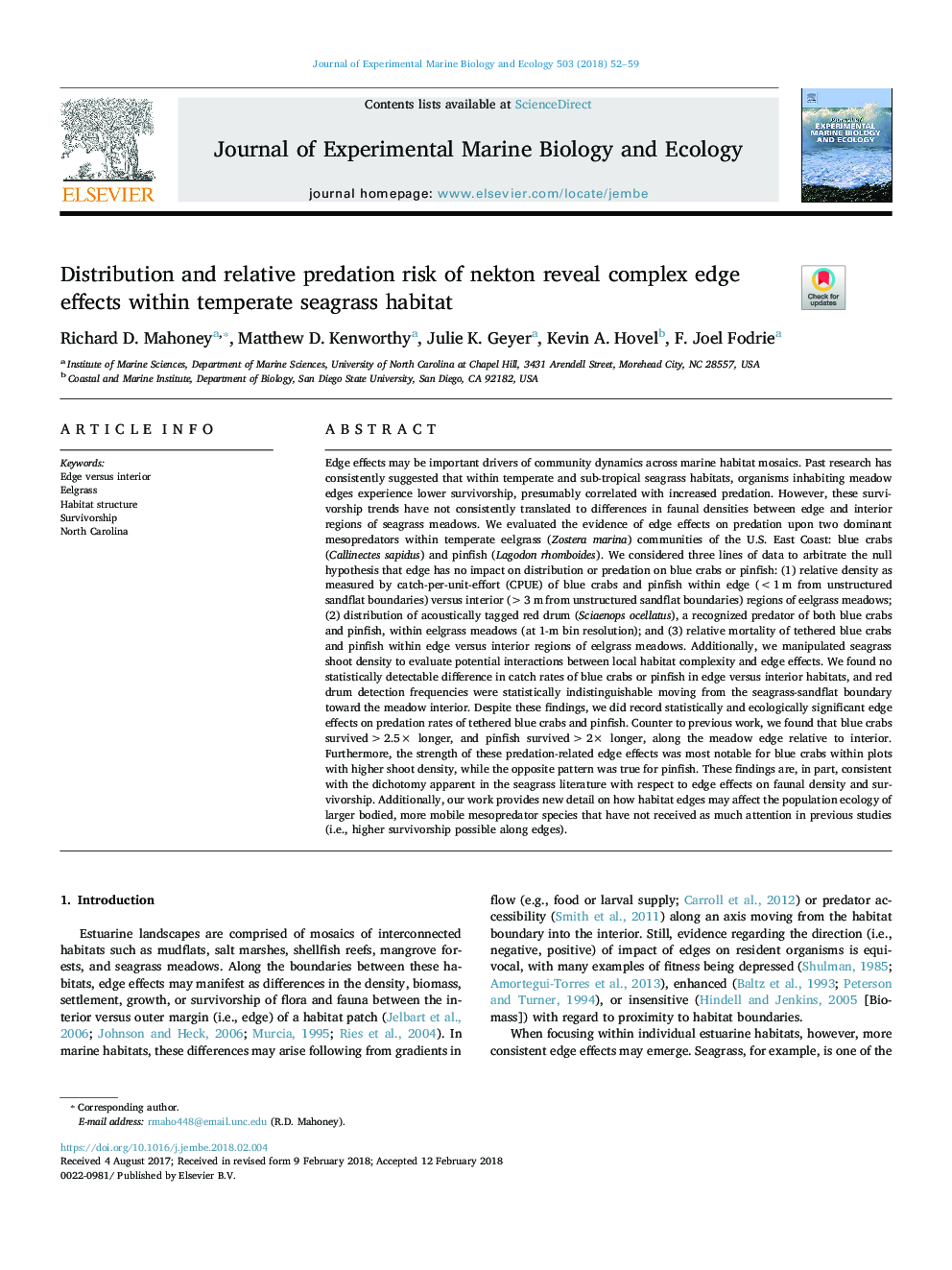| کد مقاله | کد نشریه | سال انتشار | مقاله انگلیسی | نسخه تمام متن |
|---|---|---|---|---|
| 8848924 | 1618372 | 2018 | 8 صفحه PDF | دانلود رایگان |
عنوان انگلیسی مقاله ISI
Distribution and relative predation risk of nekton reveal complex edge effects within temperate seagrass habitat
ترجمه فارسی عنوان
خطر توزیع و ریسک نسبی شغلی نکتون اثرات لبه پیچیده در زیستگاه دریایی معتدل را نشان می دهد
دانلود مقاله + سفارش ترجمه
دانلود مقاله ISI انگلیسی
رایگان برای ایرانیان
کلمات کلیدی
لبه در مقابل داخلی، ماهی قزل آلا، ساختار محل زندگی، بازمانده، کارولینای شمالی،
موضوعات مرتبط
علوم زیستی و بیوفناوری
علوم کشاورزی و بیولوژیک
علوم آبزیان
چکیده انگلیسی
Edge effects may be important drivers of community dynamics across marine habitat mosaics. Past research has consistently suggested that within temperate and sub-tropical seagrass habitats, organisms inhabiting meadow edges experience lower survivorship, presumably correlated with increased predation. However, these survivorship trends have not consistently translated to differences in faunal densities between edge and interior regions of seagrass meadows. We evaluated the evidence of edge effects on predation upon two dominant mesopredators within temperate eelgrass (Zostera marina) communities of the U.S. East Coast: blue crabs (Callinectes sapidus) and pinfish (Lagodon rhomboides). We considered three lines of data to arbitrate the null hypothesis that edge has no impact on distribution or predation on blue crabs or pinfish: (1) relative density as measured by catch-per-unit-effort (CPUE) of blue crabs and pinfish within edge (<1â¯m from unstructured sandflat boundaries) versus interior (>3â¯m from unstructured sandflat boundaries) regions of eelgrass meadows; (2) distribution of acoustically tagged red drum (Sciaenops ocellatus), a recognized predator of both blue crabs and pinfish, within eelgrass meadows (at 1-m bin resolution); and (3) relative mortality of tethered blue crabs and pinfish within edge versus interior regions of eelgrass meadows. Additionally, we manipulated seagrass shoot density to evaluate potential interactions between local habitat complexity and edge effects. We found no statistically detectable difference in catch rates of blue crabs or pinfish in edge versus interior habitats, and red drum detection frequencies were statistically indistinguishable moving from the seagrass-sandflat boundary toward the meadow interior. Despite these findings, we did record statistically and ecologically significant edge effects on predation rates of tethered blue crabs and pinfish. Counter to previous work, we found that blue crabs survived >2.5à longer, and pinfish survived >2à longer, along the meadow edge relative to interior. Furthermore, the strength of these predation-related edge effects was most notable for blue crabs within plots with higher shoot density, while the opposite pattern was true for pinfish. These findings are, in part, consistent with the dichotomy apparent in the seagrass literature with respect to edge effects on faunal density and survivorship. Additionally, our work provides new detail on how habitat edges may affect the population ecology of larger bodied, more mobile mesopredator species that have not received as much attention in previous studies (i.e., higher survivorship possible along edges).
ناشر
Database: Elsevier - ScienceDirect (ساینس دایرکت)
Journal: Journal of Experimental Marine Biology and Ecology - Volume 503, June 2018, Pages 52-59
Journal: Journal of Experimental Marine Biology and Ecology - Volume 503, June 2018, Pages 52-59
نویسندگان
Richard D. Mahoney, Matthew D. Kenworthy, Julie K. Geyer, Kevin A. Hovel, F. Joel Fodrie,
